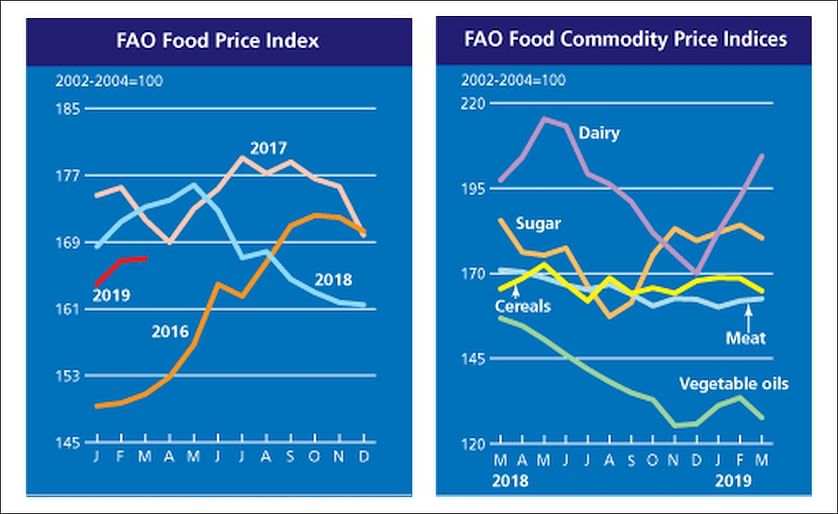The FAO Food Price Index (FFPI) held steady in March 2019, averaging 167 points and still hovering around its highest value since August 2018.
FAO Food Price Index steady in March

The FAO Food Price Index (FFPI) held steady in March 2019, averaging 167 points and still hovering around its highest value since August 2018.
A sharp increase in dairy prices and somewhat firmer meat values were offset by declining cereal, oil and sugar price quotations. This resulted in the overall value of the FFPI remaining nearly unchanged from February but down 3.6 percent from the corresponding period last year.
The FAO Cereal Price Index averaged 164.8 points in March, down 2.2 percent (3.7 points) from February and now almost at par with its March 2018 value.
Among the major cereals, wheat prices fell the sharpest, driven by large exportable supplies and a slack demand, in particular for the US origin wheat, and generally favourable prospects for this year’s harvest. Maize prices also dropped, pressured by ample export availabilities and expectations of a large crop in Argentina. International rice prices were mildly firmer in March, as weak fresh demand capped increases in the Japonica and lower quality Indica markets.
The FAO Vegetable Oil Price Index averaged 127.6 points in March, down 5.9 points (or 4.4 percent) from the previous month, mostly reflecting weakening values of palm, soy and rapeseed oils.
International palm oil prices contracted in March after three consecutive rises, underpinned by renewed concerns over subdued import demand and stock build-ups in key producing countries. At the same time, quotations for soy oil retreated as profitable margins continued to boost crushing in the United States, while rapeseed oil prices dropped to an 11 month-low, tied to accumulating rapeseed inventory levels in Canada and promising crop prospects in the Black Sea region.
The FAO Meat Price Index averaged 162.5 points in March, up marginally (0.6 points or 0.4 percent) from its revised value for February, continuing a trend of modest price volatility observed for several months. In March, price quotations for pig, bovine and poultry meats received some support from a surge in import demand, especially from China, notwithstanding increased export availabilities from major suppliers.
By contrast, price quotations for ovine meat retreated for the third month in a row because of continued large export availabilities from Oceania.
The FAO Dairy Price Index averaged 204.3 points in March, up 11.9 points (6.2 percent) from February, registering a third consecutive increase. In March, international prices of butter, Whole Milk Powder (WMP) and cheese rose, underpinned by increased import demand in anticipation of a tightening in export availabilities from Oceania stemming from a seasonal decline in its milk production.
By contrast, Skim Milk Powder (SMP) prices slipped slightly from the high values registered in February, reflecting a slowdown in demand for current deliveries.
The FAO Sugar Price Index averaged 180.4 points in March 2019, down 3.8 points (2.1 percent) from February 2019. The decline largely reflected bigger harvests in the main producing countries than previously anticipated. India is now expected to become the world’s largest sugar producer, overtaking Brazil, with the latest production estimates pointing to an 8-percent increase during October 2018-January 2019, in comparison to the same period in the previous season. Furthermore, the continued weakness of the Brazilian Real spawned additional downward pressure on world sugar prices.
A sharp increase in dairy prices and somewhat firmer meat values were offset by declining cereal, oil and sugar price quotations. This resulted in the overall value of the FFPI remaining nearly unchanged from February but down 3.6 percent from the corresponding period last year.
The FAO Cereal Price Index averaged 164.8 points in March, down 2.2 percent (3.7 points) from February and now almost at par with its March 2018 value.
Among the major cereals, wheat prices fell the sharpest, driven by large exportable supplies and a slack demand, in particular for the US origin wheat, and generally favourable prospects for this year’s harvest. Maize prices also dropped, pressured by ample export availabilities and expectations of a large crop in Argentina. International rice prices were mildly firmer in March, as weak fresh demand capped increases in the Japonica and lower quality Indica markets.
The FAO Vegetable Oil Price Index averaged 127.6 points in March, down 5.9 points (or 4.4 percent) from the previous month, mostly reflecting weakening values of palm, soy and rapeseed oils.
International palm oil prices contracted in March after three consecutive rises, underpinned by renewed concerns over subdued import demand and stock build-ups in key producing countries. At the same time, quotations for soy oil retreated as profitable margins continued to boost crushing in the United States, while rapeseed oil prices dropped to an 11 month-low, tied to accumulating rapeseed inventory levels in Canada and promising crop prospects in the Black Sea region.
The FAO Meat Price Index averaged 162.5 points in March, up marginally (0.6 points or 0.4 percent) from its revised value for February, continuing a trend of modest price volatility observed for several months. In March, price quotations for pig, bovine and poultry meats received some support from a surge in import demand, especially from China, notwithstanding increased export availabilities from major suppliers.
By contrast, price quotations for ovine meat retreated for the third month in a row because of continued large export availabilities from Oceania.
The FAO Dairy Price Index averaged 204.3 points in March, up 11.9 points (6.2 percent) from February, registering a third consecutive increase. In March, international prices of butter, Whole Milk Powder (WMP) and cheese rose, underpinned by increased import demand in anticipation of a tightening in export availabilities from Oceania stemming from a seasonal decline in its milk production.
By contrast, Skim Milk Powder (SMP) prices slipped slightly from the high values registered in February, reflecting a slowdown in demand for current deliveries.
The FAO Sugar Price Index averaged 180.4 points in March 2019, down 3.8 points (2.1 percent) from February 2019. The decline largely reflected bigger harvests in the main producing countries than previously anticipated. India is now expected to become the world’s largest sugar producer, overtaking Brazil, with the latest production estimates pointing to an 8-percent increase during October 2018-January 2019, in comparison to the same period in the previous season. Furthermore, the continued weakness of the Brazilian Real spawned additional downward pressure on world sugar prices.
Fuente
Food and Agriculture Organisation of the United Nations




